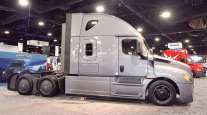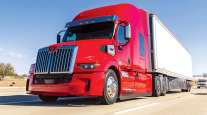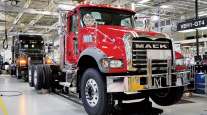Senior Reporter
November Class 8 Sales Skid to Lowest Point in Almost Two Years

[Stay on top of transportation news: Get TTNews in your inbox.]
U.S. Class 8 retail sales in November fell 12.9% year-over-year, landing at the lowest point in almost two years, WardsAuto.com reported. Industry analysts were not surprised.
Sales were 18,545 compared with 21,302 a year earlier. It was the lowest volume since February 2018, when sales hit 16,687.
“It was a fair number,” Don Ake, vice president of commercial vehicles for FTR, told Transport Topics. “It is kind of a number you would expect, and it’s not bad under the circumstances.”
At least fleets took delivery of the trucks they had ordered, Ake said, “which is still good, but the market is weakening.”
At the same time, there were deals to be had in November, said Steve Tam, vice president of ACT Research.
“There were certainly programs out there during the month designed to clear the lots of aging inventory,” he said.
He mentioned a plan in which the dealer gets the credit for sale from inventory as long as a corresponding truck is ordered.
“So they are not reducing inventory, they are just moving out stuff to make room for next year’s stuff.”
ACT forecasts U.S. Class 8 retail sales to come in at 283,300 this year, he said. “So we will have to work hard to get there, [but] the depreciation credit is out there.”
“A sizable number of small business owners are acquiring business equipment, vehicles and technology so they can expense it under Section 179 [of the U.S. tax code],” said Saul Farooqui, branch manager at lender Balboa Capital. “This business-friendly tax incentive is a key driver of capital equipment purchases because it allows business owners to deduct the full purchase price of eligible new or used equipment upfront, which allows for more immediate tax savings.”
ACT Research lowered Class 8 tractor sales forecasts, supporting the beginning of the bottoming process for truckload rates, and the Freight Forecast report provides analysis of the factors that could pull forward the eventual rate recovery. https://t.co/HAkjP87Uc9 pic.twitter.com/ID0r68JQhy
— ACT Research (@actresearch) December 12, 2019
Business vehicles topped the list of equipment that small-business owners purchased in 2019, according to the company’s latest survey.
Only Paccar Inc.’s two brands landed in positive territory; all others posted declines in sales compared with the 2018 period.
For the first 11 months, sales hit 253,266, climbing 12.8% higher than the 224,508 in the 2018 period, according to Wards. Year-to-date sales have exceeded the full-year total in the 2018 period, 250,545.
Freightliner, a Daimler Trucks North America brand, remained the market leader, selling 7,046 trucks. Sales, however, were down 16.4% compared with a year earlier. The truck maker earned a 38% market share. DTNA’s Western Star brand sold 493 trucks, down 3.3% from a year earlier. It had a 2.7% share, giving DTNA a total market share of 40.7%.
Paccar’s two brands combined for sales of 7,014, or about 500 behind DTNA.
Kenworth Truck Co. sold 3,508 trucks, a 10.1% improvement over the 2018 period and good for an 18.9% share. Peterbilt Motors Co. sold 3,506, up 5.1% from the 2018 period. It also earned an 18.9% share.
Navistar Inc.’s International brand saw sales drop 42% to 1,273 in the month, which is the beginning of Navistar’s fiscal year. International posted a 6.9% share.
Mack Trucks saw sales slide 18.3% compared with a year earlier to 1,185, good for a 6.4% share.
Volvo Trucks North America posted sales of 1,528, down 30.5% from a year earlier. It earned an 8.2% share.
“As expected, we are seeing a softening of the market with inventory levels high across the industry. We continue to monitor the situation and make adjustments when necessary,” said Magnus Koeck, VTNA vice president of marketing.
Mack and VTNA are Volvo Group brands.
The November totals also included sales by Hino Motors Manufacturing U.S.A. of six heavy-duty day cab trucks from its recently launched XL Series, giving it eight Class 8 sales for the year.
Meanwhile, Tam said, it is not surprising to see Freightliner, International and Volvo down “because they are so focused on what’s happening in the freight portion of the truck economy and that’s where the challenges lie.”
As for Mack and Western Star, this is not the construction season, he added.
One fleet executive said he was increasingly focusing on trucks with alternative powertrains.
“By the middle of next year, we will have 15 battery-electric tractors running,” said Bill Bliem, senior vice president of fleet services at NFI Industries Inc. “We have four trucks with the new near-zero natural gas engine running, and we are taking seven more this month, and will probably put another 10 more in service in the first quarter — running with renewable natural gas out there in Southern California.”
NFI by 2025 will have 35% to 50% of its fleet be zero emissions, depending who in upper management is discussing the shift, Bliem said. “We are looking at 800 to 900 tractors.”
NFI — with truckload, dedicated contract carriage and flatbed/heavy specialized units — operates about 2,300 company-owned tractors and uses 1,700 owner-operators.
NFI ranks No. 19 on the Transport Topics Top 100 list of the largest for-hire carriers in North America.
Want more news? Listen to today's daily briefing:




